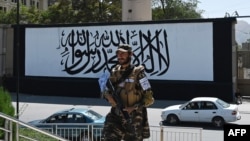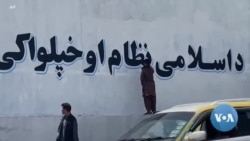Twenty-four-year-old Tamana Zaryab Paryani is too young to remember the last Taliban rule, from 1996-2001, but she recalls the horror stories her mother told her.
“My mother said Taliban were a terrorist group … it was a brutal time. They used to stone people to death,” Paryani told VOA in a WhatsApp call from Kabul, where she and nearly 20 other women are regularly protesting in the streets against the very group her mother warned her about.
“Our agenda is to get our rights, the right to education and work, freedom of expression, the right of women to be part of the Cabinet, to have equal rights for women and men,” the political science student said.
Unlike the tens of thousands who left the country since the Taliban takeover on August 15, Paryani wants to stay and fight. She said she also refuses to believe the Taliban of 2021 are different from the Taliban of 2001.
“They don’t have a single woman in their Cabinet. They will never change. They are still beating up women and harassing them. And when we protest, they beat us up too,” she said.
Some of her sentiments are shared by the international community.
“Those who hoped for, and urged for, inclusivity will be disappointed. There are no women in the names [of Cabinet members] listed. There are no non-Taliban members, no figures from the past government, nor leaders of minority groups. Instead, it contains many of the same figures who were part of the Taliban leadership from 1996 to 2001,” Deborah Lyons, the top United Nations official in Afghanistan, told the Security Council on Thursday.
Still, Lyons and other diplomats dealing with the Taliban think the new reality is still taking shape and there is space for the international community to make a difference.
The Taliban have said they need and want international assistance in running the country and, according to Lyons, have asked for “patience and even advice as they attempt to transition from a military insurgency to a government.”
They have also promised they would respect human rights and the rights of women under Islam. And while the Taliban Cabinet looks much like it did in the 1990s, the country it intends to run looks much different.
When Wadir Safi, a law professor, arrived in Kabul in 2002 after living in Australia during the Taliban regime, the city did not have any of the high-rise buildings, bright lights, or the plethora of wedding halls and restaurants that mark its landscape today.
“Slowly by 2010, the face of Kabul changed,” he said.
The country’s population nearly doubled over the last 20 years, from 21.61 million in 2001 to more than 38 million, according to World Bank estimates.
The gross domestic product that was $2.46 billion in 2001 has now grown to nearly $20 billion, according to a website called Trading Economics that gathers official data for 196 countries.
The per capita income has grown from $330 to $549; official exports increased from $166 million in 2000 to $776.73 million in 2020, and official imports increased from $2.45 billion in 2003 to $6.5 billion in 2020. These figures to not include unofficial trade through smuggling.
Under the Taliban, almost no girls and few boys went to school. The universities and institutions that existed before the Taliban takeover in 1996 were left devastated by years of war starting with the Soviet invasion of Afghanistan in 1979.
UNESCO estimated that over the next two decades, Afghanistan lost an estimated 20,000 experts and academics. After the fall of Taliban in 2001, with help of international community, things started to change.
By 2017, 46% of Afghan girls and 66% of Afghan boys were attending primary schools, according to Afghanistan Living Conditions Survey conducted by the country’s Central Statistics Organization. Half of those girls and most of those boys went on to receive a secondary education. The national youth literacy rate in people ages 15-24 climbed to 53%.
Last year, according to an Afghan Ministry of Education report, enrollment in regular schools reached 9,710,824, of which 38% were girls.
Of the 4,385 Afghans who enrolled in vocational training centers, half were female.
When Safi started teaching in Kabul university in 2002, the students were terrified. The girls, many of whom returned to college after the fall of the Taliban, would wear a burqa and were afraid to show their faces.
By the time he retired in 2017, he said things had drastically changed.
“It seemed like you were in a university in Europe. The girls and boys sat together in classes,” he said.
Those changes in attitudes were reflected in the explosive growth of mainstream and social media in Afghanistan.
From no local free press under the Taliban, the country developed more than 100 newspapers, 170 radio stations, and multiple news and entertainment television channels, according to Reuters Institute for the Study of Journalism. One sixth of Afghanistan’s population is active on social media.
The Afghan constitution, adopted in 2004, promises equal rights to men and women. The Taliban have called that constitution un-Islamic and are expected to change it.
In the last 20 years, Afghanistan developed a thriving community of artists, including females. An artists’ collective called the ArtLords, formed in 2014, took it upon itself to convert Kabul, a city full of blast walls, into the “street art capital of the world.”
Over the next six years, the group turned Kabul’s gray concrete walls into canvasses for their murals, depicting everything from schoolchildren to a Japanese aid worker who dedicated his life to Afghanistan to the historic Doha deal between the Taliban and the U.S. that led to the withdrawal of foreign forces from the country. According to its website, the collective has painted more than 2,100 murals.
Apart from “transforming the aggressive face of Kabul,” the collective also aimed to create “social transformation and behavioral change through employing the soft power of art.”
That soft power is being wiped from Kabul’s walls and replaced with black and white messages celebrating the Taliban and their ideology.
But women like Paryani have vowed that they would not be wiped away like murals.
“We don’t have an option. Our rights are being taken from us. We have to protest,” she said.






